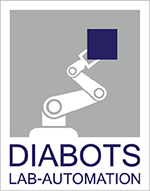Robots in medicine: a revolution
The future of health care is happening today - and robots in medicine are at the centre of it. These innovations not only arouse interest, but also fascinate with their ability to redefine the boundaries of medicine.
At Diabots, you will find these technological innovations with a visionary perspective on the automation of laboratories, as well as on increasing efficiency and improving quality in medical care. Choose the robotics solution for hospitals, laboratories or care centres today and put your trust in innovation and modernity.
Which robots can be used in medicine?
In advanced medical technology, robotics is increasingly playing a central role in improving quality and efficiency within medicine. There is a wide range of robots that can be used to improve this process. Medical facilities are taking a significant step into the future with this laboratory automation . The following are examples of robots in medicine:
Cobots, also known as collaborative robots, work hand-in-hand with medical staff.
Their ability to integrate smoothly into teams makes them an indispensable tool. Thanks to direct collaboration with collaborative robots in medicine, patient safety is improved and enhanced.
Mobile robots are revolutionising the way care and support is provided in hospitals and laboratories. They navigate independently through corridors to deliver medication, samples and even meals. The flexibility of mobile robots in healthcare allows for dynamic adaptation to the needs of the facility.
Semi-mobile robots offer a combination of mobility and stability, ideal for tasks that require both manoeuvrability and precision. They are often used in diagnostic and therapeutic applications.
Stationary robots in medicine are permanently installed in medical facilities and provide the necessary support for highly specialised tasks such as complex analyses and procedures. Their permanent presence ensures that essential services are available around the clock.

Medical robotic systems in use
Robots in medicine are already being used successfully in a variety of areas. This opens up new possibilities in diagnosis, treatment and patient care.
- Surgery: Robots make it possible to perform complex operations with increased precision and control. This includes orthopaedic surgery, cardiac surgery, neurosurgery and other specialist areas.
- Diagnostics: In diagnostic imaging and laboratories, robots can process samples with high precision and control imaging equipment. This can lead to a faster and more accurate diagnosis.
- Rehabilitation: Medical robots are used in rehabilitation medicine to support movement therapies and exercises. Here, the robots are customised specifically to the patient's needs.
- Telemedicine: Robots enable doctors to diagnose and treat patients remotely. They form the physical interface between doctor and patient.
- Sterilisation: Robots are used to sterilise medical instruments and rooms. This improves safety and hygiene in medical facilities.
- Training and simulation: In medical training, professionals can use robotic simulators to practise and demonstrate surgical techniques and improve their skills.

The economic benefits of using robots in medicine
Robots in medicine are part of the future and thus mark a turning point - not only in the quality of patient care, but also in terms of costs. The use of robots in medicine leads to substantial economic benefits. This has the potential to have a lasting impact on the healthcare sector and bring about a change in thinking.
One of the significant economic benefits of using robots in medical technology is the improvement in surgical efficiency. Thanks to laboratory robots , operations can be performed more precisely and quickly, which leads to a reduction in operating time. As a result, more patients can be treated in less time, which leads to an increase in capacity utilisation and therefore higher revenues.
At the same time, robots in the healthcare sector are helping to shorten patient recovery times. This is made possible by minimally invasive techniques. Thanks to the help of robots, patients suffer less post-operative pain. This can enable a faster return to everyday life. Costs are also reduced here, as this procedure reduces the average length of hospitalisation.
Robots taking over repetitive and precision-demanding tasks relieves the burden on medical staff. This means they can be deployed more efficiently. This can ensure financial stability for healthcare providers, which in turn could make it a more attractive career choice.
Robots in medicine: more than just a vision
In the midst of medical technologies, robots in medicine mark a significant advance.
Discover our automation solutionsto optimise processes within your facility and make them more efficient. If you have any questions about medical robotics for companies, please contact us by email at info@diabots.de or fill out our contact form. We will provide you with comprehensive and non-binding advice on your options.
FAQ - Robots in medicine
What impact do medical robots have on job satisfaction?
Our experience shows that the relief provided by robots significantly increases the job satisfaction of medical staff. The work-life balance also improves.
Are there any examples of successful implementations of Diabots robots?
Yes, we have already successfully implemented our robots in various facilities. You can get an idea of our customers in the references section.
Can the robots also be used in smaller medical practices?
Diabots offers solutions for medical facilities of all sizes. Our main focus is on hospitals with up to 650 beds, small to medium-sized hospital laboratories, central laboratories and independent laboratory groups and care centres. We customise our robotic systems to the specific needs and sizes (max. 1000 beds depending on setup) of laboratories and hospitals.


